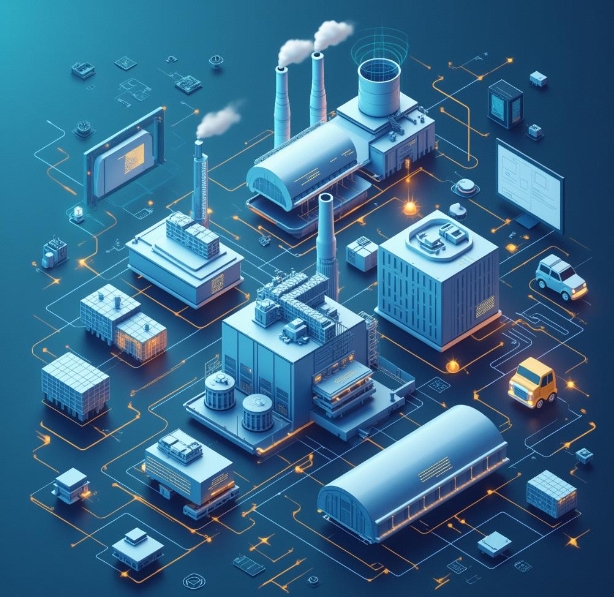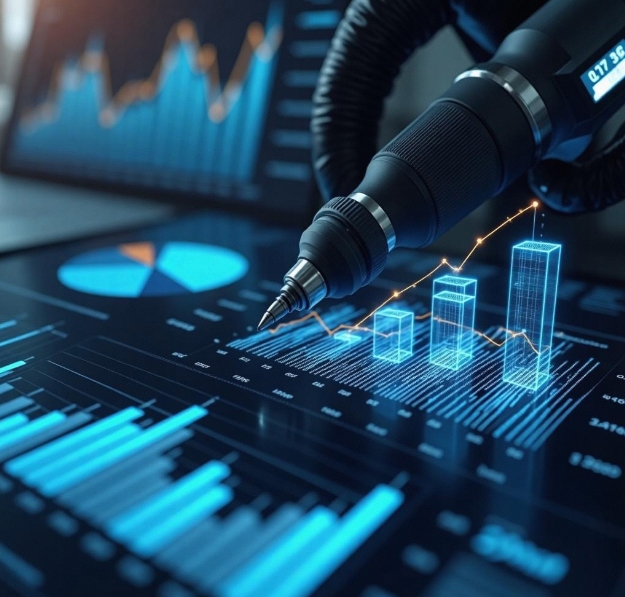Smart Factory Systems: The Core Technological Driving Force in the Age of Intelligence
- latest articles
- 1.DApp Development & Customization: Merging Diverse Market Needs with User Experience 2.Analysis of the Core Technical System in DApp Project Development 3.How to achieve cross-chain interoperability in Web3 projects? 4.How does the tokenization of points reconstruct the e-commerce ecosystem? 5.How to Set and Track Data Metrics for a Points Mall? 6.What is DApp Development? Core Concepts and Technical Analysis 7.Inventory of commonly used Web3 development tools and usage tips 8.Development of a Distribution System Integrated with Social E-commerce 9.Six Key Steps for Businesses to Build a Points Mall System 10.What is DApp Development? A Comprehensive Guide from Concept to Implementation
- Popular Articles
- 1.Future Trends and Technology Predictions for APP Development in 2025 2.Analysis of the DeFi Ecosystem: How Developers Can Participate in Decentralized Finance Innovation 3.From Zero to One: How PI Mall Revolutionizes the Traditional E-commerce Model 4.DAPP Development | Best Practices for Professional Customization and Rapid Launch 5.Recommended by the Web3 developer community: the most noteworthy forums and resources 6.From Cloud Computing to Computing Power Leasing: Building a Flexible and Scalable Computing Resource Platform 7.How to Develop a Successful Douyin Mini Program: Technical Architecture and Best Practices 8.Shared Bike System APP: The Convenient Choice in the Era of Smart Travel 9.How to Create a Successful Dating App: From Needs Analysis to User Experience Design 10.From Design to Development: The Complete Process of Bringing an APP Idea to Life
With the continuous development of global industrialization, traditional manufacturing is undergoing a profound transformation. The core driving force behind this transformation stems from the rise of the concept of "intelligentization," with the most representative direction being the construction and application of "Smart Factory" systems. By integrating advanced information technology, automation technology, artificial intelligence, and big data analytics, Smart Factories achieve comprehensive digitalization, networking, and intellectualization of production processes, becoming a vital force in driving the upgrade of the manufacturing industry.
What is a Smart Factory?
A Smart Factory is a production system built on modern information technology and smart manufacturing concepts. It relies on cloud computing, big data, artificial intelligence, the Internet of Things (IoT), 5G communication technology, and intelligent equipment to achieve intelligent control in the production process, data-driven decision-making, and maximized production efficiency. Unlike traditional factories, Smart Factories have greater flexibility and adaptability, enabling them to respond quickly to changes in market demand while reducing operational costs and resource waste.
In a Smart Factory, equipment is not merely a passive executor but an intelligent entity with multiple functions such as perception, decision-making, and execution. Through real-time interaction with the external environment, the Smart Factory can provide immediate feedback and optimization for issues in the production process, ultimately achieving efficient and precise production.
Components of a Smart Factory System
The construction of a Smart Factory involves the integration of technologies from multiple fields. Below are its core components:
1. Internet of Things Technology
The Internet of Things (IoT) is one of the key technologies enabling intelligent management in Smart Factories. By installing sensors and smart devices in equipment, production lines, warehouses, logistics, and other areas, factories can collect vast amounts of data in real time and transmit it to a central system for analysis. This data includes various types of information such as temperature, humidity, vibration, pressure, and location. The application of IoT technology significantly enhances the visibility and controllability of the production process, allowing factories to monitor equipment status and production progress in real time.
2. Big Data Analytics and Cloud Computing
In Smart Factories, the massive amounts of data generated during production are stored, processed, and analyzed using big data technologies. Big data analytics helps managers extract valuable insights, identify potential production bottlenecks, quality risks, and resource waste points, providing data support for decision-making. Through cloud computing platforms, various production stages in the factory can share data in real time, enabling information exchange between different departments.
3. Artificial Intelligence and Machine Learning
Artificial Intelligence (AI) and machine learning are increasingly widely applied in Smart Factories. AI technology enables factory equipment and systems to possess self-learning and optimization capabilities. For example, AI can predict the occurrence of equipment failures by analyzing production data, avoiding production losses caused by downtime. Additionally, machine learning algorithms can optimize production processes, improving production efficiency and product quality. The introduction of AI technology gives Smart Factories the ability for autonomous decision-making and real-time response.
4. Automation and Robotics Technology
Automation technology is one of the foundations for achieving efficient production in Smart Factories. In these factories, automated equipment and industrial robots are widely used in various stages of the production line, from material handling to assembly, welding, painting, and more. Automation technology not only increases production speed and precision but also reduces human intervention, minimizing the occurrence of human errors.
5. 5G Communication Technology
5G communication technology provides Smart Factories with higher transmission speeds and lower latency, making data transmission and real-time control between devices possible. The application of 5G technology significantly enhances the response speed of IoT devices, ensuring real-time monitoring and scheduling during the production process. This is crucial for industrial production requiring high precision and reliability.

Core Technologies of the Smart Factory System
The construction of a Smart Factory system relies on the support of the following core technologies:
1. Real-Time Data Collection and Transmission Technology
Data is the core of Smart Factory operations. In a Smart Factory, real-time data collection and transmission are crucial for production monitoring, equipment management, logistics scheduling, and other aspects. IoT technology collects various data from the production line through sensors, while 5G and industrial Ethernet ensure the high-speed and stable transmission of this data to the central processing system. With these technologies, factories can grasp production conditions in real time, adjust production strategies promptly, and avoid various risks during the production process.
2. Edge Computing Technology
Edge computing refers to the technology of processing and computing data at the source. As the number of devices in Smart Factories increases, the volume of data grows exponentially. Through edge computing, factories can perform preliminary data processing at the device end, reducing the pressure on data transmission and improving response speed. Additionally, edge computing ensures the normal operation of equipment even when network failures occur.
3. Digital Twin Technology
Digital twin technology involves creating a virtual model of physical equipment or systems to reflect their working status, performance, and environmental changes in real time. The application of digital twin technology in Smart Factories enables comprehensive monitoring and predictive maintenance of equipment. By comparing with actual equipment, factories can identify potential issues in advance, preventing equipment failures and production accidents.
4. Human-Machine Collaboration Technology
With the development of artificial intelligence and robotics, human-machine collaboration is increasingly applied in Smart Factories. AI and robots can collaborate with workers to complete complex tasks. Through the coordination of intelligent robots and workers, processes on the production line can be optimized, significantly improving work efficiency. Human-machine collaboration not only reduces labor intensity but also enhances product quality.
Advantages of Smart Factories
The implementation of Smart Factories not only enhances production efficiency but also brings multiple advantages:
1. Improved Production Efficiency
Smart Factories significantly increase production efficiency through automation and intelligent means. Smart equipment and robots can operate 24/7, greatly shortening production cycles. Meanwhile, factories can adjust production rhythms in real time through data monitoring and big data analytics, avoiding waste during the production process.
2. Enhanced Product Quality
Smart Factories ensure that every product meets quality standards through precise data monitoring and quality control. Artificial intelligence and machine learning can analyze production data, identify potential quality issues, and make adjustments, thereby preventing defective products from entering the market.
3. Reduced Operational Costs
Intelligent equipment reduces reliance on manual labor, lowering labor costs. Through real-time optimization of the production process and early warning systems, factories can minimize equipment failures, downtime, and production waste, further reducing overall operational costs.
4. Increased Flexibility and Customization Capability
Smart Factories can flexibly adjust production plans and product specifications according to changes in market demand. Through intelligent production scheduling systems, factories can achieve small-batch, multi-variety customized production to meet personalized needs. This provides enterprises with stronger market competitiveness.

Challenges and Prospects of Smart Factories
Although Smart Factory systems offer significant advantages, they still face some challenges in practical application. Firstly, the difficulty of technology integration: Smart Factories involve numerous and complex technologies, and achieving efficient integration while ensuring system stability is a challenge. Secondly, data security issues: as production data becomes digitized, protecting this data from hacker attacks and leaks has become an urgent problem to solve.
Despite these challenges, the application prospects for Smart Factories remain very broad with continuous technological advancements. In the future, with the further development of emerging technologies such as 5G, artificial intelligence, and blockchain, Smart Factories will become more intelligent, flexible, and efficient, serving as a crucial engine for promoting the transformation and upgrade of global manufacturing.
Conclusion
As a core technological driving force in the era of intelligentization, Smart Factory systems are leading the transformation of the manufacturing industry. Through the deep integration of technologies such as the Internet of Things, big data, and artificial intelligence, Smart Factories not only improve production efficiency and reduce costs but also enhance product quality and market responsiveness. Although facing some technical and security challenges, with continuous technological development and innovation, Smart Factories will see broader application prospects in the future, propelling global manufacturing into a new era of greater intelligence and efficiency.
-

How does artificial intelligence technology transform the operational models of modern enterprises?
In the wave of the digital era, artificial intelligence (AI) technology has tran···
-

How to Utilize Artificial Intelligence for Precision Medicine and Health Management
With the rapid advancement of technology, artificial intelligence (AI) has demon···
-

Integration and Application of Artificial Intelligence and Robotics
In today's era of rapid technological advancement, the integration of artificial···

 Blockchain
Blockchain










